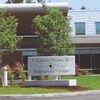A new tack | A group of maritime professionals transforms the defunct Belfast cannery
 Photo/Amber Waterman
J.B. Turner is leaving composite boat builder Kenway Corp. in Augusta, pictured above, to head up the new Front Street Shipyard in Belfast. Kenway and two local boatyards are partners in the venture.
Photo/Amber Waterman
J.B. Turner is leaving composite boat builder Kenway Corp. in Augusta, pictured above, to head up the new Front Street Shipyard in Belfast. Kenway and two local boatyards are partners in the venture.
The former Stinson sardine cannery in Belfast has sat vacant and neglected for a decade, a relic of Maine’s once-robust seafood processing heritage. A glimmer of hope came in 2005, when Belfast Bridge LLC envisioned a new, much more modern use for the property: condominiums. But money for the ambitious $12 million project dried up, a legal battle with the city ensued and the waterfront site sat in limbo.
But now, a group of veteran maritime professionals has come together to breathe new life into the nearly four-acre property by returning it to yet another traditional Maine industry: boating. Backing the new business, called Front Street Shipyard, are Taylor Allen, owner of Rockport Marine; Steven White, president of Brooklin Boat Yard; and Ken Priest, president of composite manufacturer Kenway Corp. in Augusta, along with J.B. Turner, Kenway’s director of advanced technology. The men plan to develop a servicing and restoration facility for commercial and private boats, with a key asset being the installation of the largest travel lift in the state, which can accommodate boats up to 120 feet long. Boat building and launching equipment for offshore wind and tidal energy projects are also in their sights for the shipyard, which will open this summer.
Overseeing the site and its several derelict buildings, purchased in mid-January and assessed by the town at nearly $1.1 million, is Turner, a 24-year veteran of the industry. Formerly the president of Lyman-Morse Boatbuilding Co. in Thomaston and service manager for Wayfarer Marine in Camden, Turner is leaving his job at Kenway to oversee the day-to-day operations of Front Street Shipyard, while Priest, Allen and White continue to man the helms at their respective businesses. Turner took some time to tell us about his group’s vision for the property. Below is an edited transcript of the conversation.
Mainebiz: Tell us about the timeline for getting Front Street Shipyard up and running.
Turner: We hope to have the travel lift up and running by July 1, at the latest. Meaning the travel lift, piers, and putting floating docks in so we can handle transients. Actually, we have some interest in seasonal slip rentals as well already, which is great. We’ve had three people call.
So the lift will allow you to accommodate much larger boats?
The lift is going to be 165 U.S. tons, so generally speaking somewhere around 120 feet, depending on the size and shape of the boat. And we’ll have deep water access, we’ll have 16 feet. So eventually we’ll be able to handle a 180-foot boat there on the face of the dock, not this season, but by next season.
How does it compare to what’s currently available for larger boats in Maine?
Right now, as far as we understand it, the biggest lift is the Hinckley lift [in Southwest Harbor], which is 150 U.S. tons. And Gowen Marine in Portland also has the same size.
Why do you think there’s a market for that size boat coming into Maine?
We’re hoping to service a broad range of boaters, not only the big boats, but we want to have what I call “regular customers” who are seasonal customers that we take care of in the winter and take care of in the summer. People like me, and Ken Priest, who has a J-35 [sailboat]. We want to be able to service those people, that’s our first market that we want to develop. The larger boats, they’re basically moving all over the Earth, from the Pacific to the Atlantic to Europe to the U.S. through the Caribbean. So there is a market for the servicing of those boats.
Plus, the captains of those bigger boats like coming to Maine, it’s a beautiful place to sail, it’s a good value-oriented feel, they feel that they’re getting a good value for their dollar spent, and they just love being in the area. A lot of the captains I’ve known over the years, once they get off the boat, they end up settling in Maine, which is fantastic, because it makes more want to come here.
Had your group hatched the idea for this project and were just looking for the right spot to locate it?
I had left Lyman-Morse in January of last year. Steve White and Taylor Allen had been looking for several years for a facility or for an area to build a facility that could handle bigger projects. Boats at their yards, Rockport Marine and Brooklin Boat Yard, are fairly limited. Rockport Marine is one acre and Brooklin Boat Yard is two acres, so they don’t have the facility or the area to have a bigger lift and a bigger project. So those two have been looking for years. Once I left Lyman-Morse, I joined Kenway, which is Ken Priest’s business, and back in March we started kicking around the idea of Belfast. We kind of latched onto the area because of the land being very flat, and therefore excellent for a boat yard, because most boat yards in Maine have to deal with hills. I sat down and talked to Ken about it in early fall, and he was all for it. So we kind of joined together then and added a couple more people near the end.
Tell us about the investment structure for the project.
It’s the four of us plus two more: one is Lucia Michaud, who is Taylor’s sister, and the other is someone named Jack Rettig, who is a friend of an old customer of mine from Lyman-Morse. He just sold his business and was looking for a different investment opportunity.
Can you share how much you personally or the group has invested?
I’d rather leave the numbers out. It’s too scary, (laughs) I have a hard enough time sleeping. All in all, we’re probably going to be investing over $5 million into the facility over the next three years.
Rockport Marine and Brooklin Boat Yard both focus on wooden boats. So what unique experience do they each offer this project?
They have customers who are just very loyal to each particular yard, which I find amazing because you stand back 10 feet and you go, “These guys are the same.” But there are people who would never leave Rockport Marine and there are people who would never leave Brooklin Boat Yard, and they would never leave one to go to the other, they’re very loyal to them. But there are differences. Rockport Marine is a little bit more into the plank-on-frame boat building, so they do a lot of cold-molded work. Brooklin Boat Yard is really into the cold-molded, composite-ish boat building. I’m all fiberglass.
It helps to round us all out — I bring the composite boat building, Kenway brings in the composite building in general, all types of manufacturing in composites, whether it’s industrial or wind or whatever, and then we have the more traditional boat building, the wood and then the wood composites. If you take the four of us as owners, there’s a heck of a lot of depth and knowledge. If a customer was bringing their boat to us, whether it was a wooden boat or a composite boat, I think we can answer almost all of their questions between the four of us, which is not available in a lot of yards from the ownership side.
Will one of those areas of expertise make up the bulk of the business?
Who knows what the phone’s going to bring. It could be that we start building carbon fiber racing sleds, or we could build plank-on-frame 120-foot boats, it doesn’t matter, we could do either one. That’s the fun part of it. Servicing is our primary goal, building and big refit projects we’ll take as we can get them. There will be times where I’ll be bidding against Taylor and Steve on some projects, I’m sure.
What will be your partners’ role in the shipyard, since they’re busy running their own businesses?
Any larger projects that come along, they’ll be bringing to the shipyard, and probably inserting some of their people or themselves into the project management of one of those bigger projects. Say someone wanted to build a 120-foot wooden, cold-molded sloop or powerboat. I think they’d probably have some of their guys overseeing that part of the project, working with the regular guys at Front Street. We’ll have composites, we’ll have the systems people, we’ll have the joiners on hand, but for a bigger project we’ll be able to pull in different resources, which is another opportunity. If we get composite hulls that are under 80 feet, for example, Kenway would build the molds and the hulls and the decks and ship them down Route 3 to Belfast, and we’d have an assembly crew there. We’ve got Kenway with 43,000 square feet right in Augusta and a nice, straight road between the two.
With the recession, people don’t think of yachting and boat building being especially strong right now. How do you see that market?
On the production side of things, they’re absolutely right. But there is still a market for all the people who have the boats and want to have them taken care of. There’s certainly a lot of projects in the last two years that have come about because people are getting good deals on boats, but wanting to change them to the way they live. So refit work has been very high all over the place, people are getting a great deal on the boat but saying, “Instead of building this custom boat, now I’m going to change it into the boat that I wanted.”
Do you expect most of your customers will come from outside of Maine?
Numbers-wise, most of our customers will be in Maine, the storage customers, that’s what’s going to keep us alive, the storage and the seasonal slip people. Then we’ll fill in; it’s the same thing we did at Lyman-Morse and what Wayfarer does. They have their seasonal and very important storage customers and then they have bigger boats that come up for the summer. You can’t build a business on just the three months of summer, really the one-and-a-half months of summer when you get down to it, [when] the big boats are here.
How many people do you plan to employ?
It’s hard to say because we don’t know how well the phone’s going to ring, but I hope we’ll have 25 or so by fall, and in the three- to five-year scheme, I hope we can do 100.
Jackie Farwell, Mainebiz senior writer, can be reached at jfarwell@mainebiz.biz.










Comments